Why redialling does not function on my Panasonic Telephone?
- SsgardnerSep 23, 2025
If redialling does not function on your Panasonic Telephone, the dialled number was more than 32 digits.






Why redialling does not function on my Panasonic Telephone?
If redialling does not function on your Panasonic Telephone, the dialled number was more than 32 digits.
Why the parallelled single line Panasonic Telephones do not ring?
If the parallelled single line Panasonic Telephones do not ring, it may be because "No ring" is selected. Change the setting to ring.
What to do if IP-PTs/SIP phones do not operate on my Panasonic KX-NS300?
If your IP-PTs/SIP phones are not operating with your Panasonic PBX, it could be due to several reasons: * A malfunctioning DSP card: Replace the card. * A malfunctioning motherboard: Replace the motherboard after turning off the PBX. * Insufficient activation keys: Purchase additional activation key codes from a certified dealer. * The IP-PT/SIP phone is not registered: Register the phone. * The IP-PT/SIP phone malfunction: Replace the phone. * Poor connection: Ensure an 8-pin twisted pair cable is used, CAT 5/CAT 5e cables are not longer than 100m, and a straight cable is used for connection to a switching hub. * Network malfunction: Ensure all network devices are on and the IP-PT/SIP phone isn't blocked by a firewall or other network devices.
How to fix Panasonic Telephone that does not work properly?
If your Panasonic Telephone is not working properly, first confirm with your manager that your settings are correct. If the problem persists, consult your dealer.
What to do if I cannot remember the feature numbers on my Panasonic Telephone?
If you cannot remember the feature numbers on your Panasonic Telephone, it may be because they have been changed from the default values. In that case, ask your dealer to change the feature numbers for easier use.
How to improve the visibility of the display that is poor on my Panasonic Telephone?
If the visibility of the display is poor on your Panasonic Telephone, change the Display contrast level.
Why I cannot send a call waiting tone to the dialled extension on my Panasonic Telephone?
If you cannot send a call waiting tone to the dialled extension on your Panasonic Telephone, it could be because the other party has not set the Call Waiting feature or the other party has set Data Line Security.
What to do if the background music started suddenly on my Panasonic Telephone?
If the background music started suddenly on your Panasonic Telephone, turn off the music.
What to do if none of the operations work when using a proprietary Panasonic Telephone?
If none of the operations work when using a proprietary Panasonic Telephone, even after following the manual instructions, it may be because the Intercom line was not seized. If the setting has been changed, press the INTERCOM or PDN button after going off-hook and follow the instructions.
Why is a reorder tone audible or "Restricted" displayed on my Panasonic Telephone?
A reorder tone or the display of "Restricted" on your Panasonic Telephone could be due to several reasons. First, the telephone might be locked, so try unlocking it. Second, toll restriction might be activated, in which case you should consult your manager or dealer. Finally, an account code might be required.
Covers essential preliminary information before using the telephones, including safety and data security.
Provides critical safety precautions and warnings for operating the telephone equipment to prevent injury or damage.
Details fundamental safety guidelines for using telephone equipment, focusing on electrical shock and environmental factors.
Outlines security requirements for the PBX to prevent data loss, leakage, and unauthorized access.
Explains the types of telephones compatible with the PBX and general operating procedures.
Covers various methods for initiating calls, including internal, external, and private network calls.
Details the fundamental procedures for making calls, such as calling extensions or outside parties.
Explains convenient methods for dialling frequently used numbers using one-touch buttons or stored numbers.
Describes how to redial the last dialled number for convenience.
Covers features for handling busy lines or no-answer situations, such as reserving a line or setting callbacks.
Explains how to access services provided by the ISDN.
Details how to change the alerting method between ringing and voice for intercom calls.
Explains how to use calling privileges at another extension or with verification codes.
Describes how to access extensions directly from outside without operator assistance.
Explains how to set telephone features remotely from another extension or via DISA.
Covers procedures for answering calls using various methods.
Details the basic methods for answering incoming calls.
Explains how to answer calls hands-free without going off-hook.
Describes how to answer calls ringing at other extensions or groups from your own phone.
Explains how to answer incoming outside calls through an external speaker.
Details the functions of the ANSWER and RELEASE buttons for call handling.
Explains how to trace malicious callers using the MCID feature.
Covers features and operations performed while a call is in progress.
Details various methods for transferring calls to extensions, outside parties, or using ISDN/SIP services.
Explains how to place calls on hold and retrieve them, including regular and exclusive hold modes.
Describes how to swap between two parties during a conversation.
Explains how to handle incoming calls when already on a call, including disconnecting or holding the current call.
Covers procedures for establishing and managing conference calls with multiple participants.
Details how to disable the microphone to consult privately during a call.
Explains how to allow others to listen to a conversation through the speaker.
Provides instructions on using a headset for conversations.
Explains the use of Primary and Secondary Directory Number buttons for call handling.
Details the functions and status indications of PDN and SDN buttons.
Covers features for managing calls and messages when you are away from your desk.
Explains how to forward incoming calls to a specified destination based on various conditions.
Describes how to display a message to callers when you are unavailable.
Explains how to lock your extension to prevent unauthorized calls.
Covers the features of the PBX's answering machine service, including recording and retrieving messages.
Details features for making and answering voice announcements.
Explains how to make voice announcements to groups of telephones or external speakers.
Describes how to answer or deny incoming paging announcements.
Covers procedures for establishing conference calls with multiple parties.
Introduces the Unified Messaging system and its capabilities.
Provides an overview of the Unified Messaging system's features and benefits.
Details the process of logging in, setting up, and configuring your mailbox.
Explains how to play, manage, and interact with voice messages.
Covers methods for sending messages to subscribers and external parties.
Details various methods for transferring calls, including incomplete call handling.
Describes additional features such as interview mailboxes and personal custom services.
Provides a summary of frequently used features and their corresponding access codes.
Covers features to customize telephone functions and settings.
Explains how to set timed reminders or wake-up calls.
Details how to prevent incoming calls from ringing at your extension.
Covers features for handling incoming calls during an active conversation.
Explains how to display your telephone number to called or calling parties.
Describes how to prevent your telephone number from being displayed to the caller.
Explains how to prevent your telephone number from being displayed to the called party.
Details how to prevent others from joining your conversation.
Explains how to play background music through the telephone speaker.
Covers features to protect the line against audible notification tones for secure data transmission.
Explains how to check the current status of the Time Service on the display.
Describes how to configure whether a parallelled single line telephone rings for incoming calls.
Explains how to use PS or S-PS in parallel with a wired telephone.
Details how to set two telephones to share one extension number and ring simultaneously.
Explains how to reset extension features to their default settings.
Covers features related to managing incoming calls within a call distribution group.
Details how to control your status within an incoming call distribution group.
Explains how supervisors can monitor and control call status and agent login/logout.
Describes how to manually forward the longest waiting call in a queue to a preset destination.
Covers features related to connected external equipment like doorphones, relays, and sensors.
Explains how to talk to and open the door via the doorphone.
Details how to switch on a relay (e.g., alarm) connected to the PBX.
Explains how to receive alert calls from external sensors.
Covers accessing external services offered by a host PBX or telephone company.
Details features when a Voice Processing System is connected, including voicemail integration.
Covers administrative tasks and features, particularly in a hotel environment.
Explains how hotel operators can manage room status and services using telephones.
Describes how to record information using preprogrammed messages for various purposes.
Covers features for exchanging telephone settings between extensions.
Explains how to exchange telephone settings with another extension.
Details how to change extension status to 'Service-in' or 'Service-out'.
Covers features that utilize the telephone display, such as call logs and directories.
Explains how to view and use the incoming and outgoing call logs.
Describes how to use personal speed dialling, system speed dialling, and extension number directories.
Explains how to access system features through the 'Feature Access' menu.
Details how to customize flexible buttons with LCD screens on specific telephone models.
Covers features available for cellular phones when used with the PBX.
Explains features like transferring calls and conference for cellular phones.
Covers features that allow managers to control other extensions.
Details how managers can lock or unlock other extensions remotely.
Explains how managers can change the time mode (Day/Night/Lunch/Break).
Covers changing the restriction level for calls.
Details how managers can select and broadcast background music.
Explains how managers can record greeting messages for various purposes.
Covers how managers can re-enable an unavailable outside line for use.
Details how managers can stop monitoring extensions connected to another PBX.
Covers configuration of Unified Messaging system features.
Details features and procedures for the System Manager.
Covers features and procedures for the Message Manager.
Covers personal customization of telephone features and settings.
Explains how to customize individual telephone features and button features.
Details various settings that can be programmed for telephones.
Covers how to customize flexible and programmable feature buttons.
Describes how to use the Web Maintenance Console for system programming.
Guides users through editing personal information and system settings via the console.
Covers programming functions available to managers.
Provides an overview of the programming items managers can access.
Details how managers can change call charges and control extensions.
Explains how supervisors can monitor and control call distribution groups.
Provides a comparative list of features supported by different telephone types.
Details feature support across various telephone types like PT, PS, SLT, and SIP phones.
Offers solutions for common problems encountered during operation.
Provides guidance on diagnosing and resolving telephone system issues.
Lists default feature numbers and required digits/buttons for operations.
A reference table detailing feature codes and dial sequences.
Explains various tones heard during telephone operations.
Details the meaning of different ring and dial tones.
Covers essential preliminary information before using the telephones, including safety and data security.
Provides critical safety precautions and warnings for operating the telephone equipment to prevent injury or damage.
Details fundamental safety guidelines for using telephone equipment, focusing on electrical shock and environmental factors.
Outlines security requirements for the PBX to prevent data loss, leakage, and unauthorized access.
Explains the types of telephones compatible with the PBX and general operating procedures.
Covers various methods for initiating calls, including internal, external, and private network calls.
Details the fundamental procedures for making calls, such as calling extensions or outside parties.
Explains convenient methods for dialling frequently used numbers using one-touch buttons or stored numbers.
Describes how to redial the last dialled number for convenience.
Covers features for handling busy lines or no-answer situations, such as reserving a line or setting callbacks.
Explains how to access services provided by the ISDN.
Details how to change the alerting method between ringing and voice for intercom calls.
Explains how to use calling privileges at another extension or with verification codes.
Describes how to access extensions directly from outside without operator assistance.
Explains how to set telephone features remotely from another extension or via DISA.
Covers procedures for answering calls using various methods.
Details the basic methods for answering incoming calls.
Explains how to answer calls hands-free without going off-hook.
Describes how to answer calls ringing at other extensions or groups from your own phone.
Explains how to answer incoming outside calls through an external speaker.
Details the functions of the ANSWER and RELEASE buttons for call handling.
Explains how to trace malicious callers using the MCID feature.
Covers features and operations performed while a call is in progress.
Details various methods for transferring calls to extensions, outside parties, or using ISDN/SIP services.
Explains how to place calls on hold and retrieve them, including regular and exclusive hold modes.
Describes how to swap between two parties during a conversation.
Explains how to handle incoming calls when already on a call, including disconnecting or holding the current call.
Covers procedures for establishing and managing conference calls with multiple participants.
Details how to disable the microphone to consult privately during a call.
Explains how to allow others to listen to a conversation through the speaker.
Provides instructions on using a headset for conversations.
Explains the use of Primary and Secondary Directory Number buttons for call handling.
Details the functions and status indications of PDN and SDN buttons.
Covers features for managing calls and messages when you are away from your desk.
Explains how to forward incoming calls to a specified destination based on various conditions.
Describes how to display a message to callers when you are unavailable.
Explains how to lock your extension to prevent unauthorized calls.
Covers the features of the PBX's answering machine service, including recording and retrieving messages.
Details features for making and answering voice announcements.
Explains how to make voice announcements to groups of telephones or external speakers.
Describes how to answer or deny incoming paging announcements.
Covers procedures for establishing conference calls with multiple parties.
Introduces the Unified Messaging system and its capabilities.
Provides an overview of the Unified Messaging system's features and benefits.
Details the process of logging in, setting up, and configuring your mailbox.
Explains how to play, manage, and interact with voice messages.
Covers methods for sending messages to subscribers and external parties.
Details various methods for transferring calls, including incomplete call handling.
Describes additional features such as interview mailboxes and personal custom services.
Provides a summary of frequently used features and their corresponding access codes.
Covers features to customize telephone functions and settings.
Explains how to set timed reminders or wake-up calls.
Details how to prevent incoming calls from ringing at your extension.
Covers features for handling incoming calls during an active conversation.
Explains how to display your telephone number to called or calling parties.
Describes how to prevent your telephone number from being displayed to the caller.
Explains how to prevent your telephone number from being displayed to the called party.
Details how to prevent others from joining your conversation.
Explains how to play background music through the telephone speaker.
Covers features to protect the line against audible notification tones for secure data transmission.
Explains how to check the current status of the Time Service on the display.
Describes how to configure whether a parallelled single line telephone rings for incoming calls.
Explains how to use PS or S-PS in parallel with a wired telephone.
Details how to set two telephones to share one extension number and ring simultaneously.
Explains how to reset extension features to their default settings.
Covers features related to managing incoming calls within a call distribution group.
Details how to control your status within an incoming call distribution group.
Explains how supervisors can monitor and control call status and agent login/logout.
Describes how to manually forward the longest waiting call in a queue to a preset destination.
Covers features related to connected external equipment like doorphones, relays, and sensors.
Explains how to talk to and open the door via the doorphone.
Details how to switch on a relay (e.g., alarm) connected to the PBX.
Explains how to receive alert calls from external sensors.
Covers accessing external services offered by a host PBX or telephone company.
Details features when a Voice Processing System is connected, including voicemail integration.
Covers administrative tasks and features, particularly in a hotel environment.
Explains how hotel operators can manage room status and services using telephones.
Describes how to record information using preprogrammed messages for various purposes.
Covers features for exchanging telephone settings between extensions.
Explains how to exchange telephone settings with another extension.
Details how to change extension status to 'Service-in' or 'Service-out'.
Covers features that utilize the telephone display, such as call logs and directories.
Explains how to view and use the incoming and outgoing call logs.
Describes how to use personal speed dialling, system speed dialling, and extension number directories.
Explains how to access system features through the 'Feature Access' menu.
Details how to customize flexible buttons with LCD screens on specific telephone models.
Covers features available for cellular phones when used with the PBX.
Explains features like transferring calls and conference for cellular phones.
Covers features that allow managers to control other extensions.
Details how managers can lock or unlock other extensions remotely.
Explains how managers can change the time mode (Day/Night/Lunch/Break).
Covers changing the restriction level for calls.
Details how managers can select and broadcast background music.
Explains how managers can record greeting messages for various purposes.
Covers how managers can re-enable an unavailable outside line for use.
Details how managers can stop monitoring extensions connected to another PBX.
Covers configuration of Unified Messaging system features.
Details features and procedures for the System Manager.
Covers features and procedures for the Message Manager.
Covers personal customization of telephone features and settings.
Explains how to customize individual telephone features and button features.
Details various settings that can be programmed for telephones.
Covers how to customize flexible and programmable feature buttons.
Describes how to use the Web Maintenance Console for system programming.
Guides users through editing personal information and system settings via the console.
Covers programming functions available to managers.
Provides an overview of the programming items managers can access.
Details how managers can change call charges and control extensions.
Explains how supervisors can monitor and control call distribution groups.
Provides a comparative list of features supported by different telephone types.
Details feature support across various telephone types like PT, PS, SLT, and SIP phones.
Offers solutions for common problems encountered during operation.
Provides guidance on diagnosing and resolving telephone system issues.
Lists default feature numbers and required digits/buttons for operations.
A reference table detailing feature codes and dial sequences.
Explains various tones heard during telephone operations.
Details the meaning of different ring and dial tones.
| System Type | Hybrid IP-PBX |
|---|---|
| Built-in Analog Extensions | 2 |
| Power Supply | AC 100-240 V, 50/60 Hz |
| IP Terminals Supported | Yes |
| Analog Terminals Supported | Yes |
| Digital Terminals Supported | Yes |
| Built-in Voicemail | Yes |
| Built-in Conference Bridge | Yes |
| Dimensions | 430 mm x 88 mm x 367 mm |
| Networking | SIP, H.323 |
| Built-in VoIP Channels | None (Requires optional DSP card) |



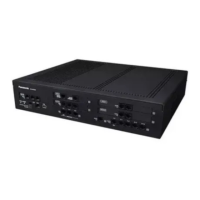



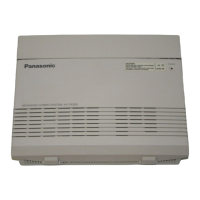

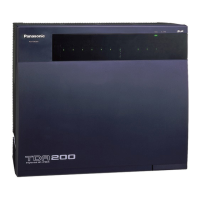
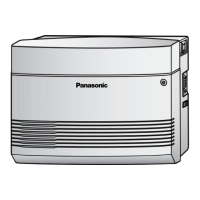
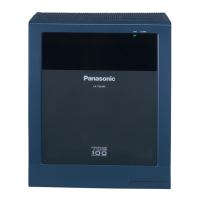
